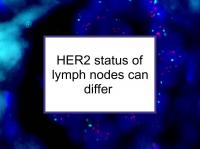While previously it was assumed that the receptor status (estrogen receptor (ER), progesterone receptor (PR), or human epidermal growth factor receptor 2 (HER2)) of breast cancer remained constant over time and during progression to metastasis, there is mounting evidence that receptor status changes can occur.
Treatment for what amounts to the wrong receptor status is possible if the receptor status of metastases is not assessed. Tailoring treatment to the receptor status of metastases makes sense since breast cancer cells that have metastasized presumably are the most aggressive and therefore should be targeted. Now a new study has reported that changes in HER2 status can occur early in disease progression.
Discordance could influence prognosis
A difference between the ER, PR, or HER2 status of a primary tumor and its corresponding metastases (including lymph node metastases) is known as "discordance." PR status changes are more common than ER changes; HER2 changes are the least likely. Changes in ER or HER2 status can be a marker of increased disease aggressiveness. The significance of a change in PR status has not been established.
Discordance is a relatively new concept and still somewhat controversial, especially with respect to HER2 status. Estimates of the prevalence of HER2 discordance vary and problems with assessing HER2 may have contributed to the frequency of discordance reported in some studies. However, it is apparent that some level of discordance does exist and it would benefit patients to have it assessed for all three types of receptors.
Latest research finds some HER2 lymph node discordance
The study referenced at the beginning of this news story was designed to investigate the frequency of HER2 discordance between the primary tumor and positive lymph nodes of women with early stage breast cancer. The study was performed by retrospectively determining the HER2 status of 148 primary tumors and their positive lymph nodes collected at the time of initial breast cancer surgery. The patients had average age 59 (range: 33 to 96 years). The authors used immunohistochemistry and fluorescence in situ hybridization to determine HER2 status.
At 95.28%, the overall HER2 concordance rate was high. A total of 89 cases had HER2- tumors and lymph node metastases and 52 cases had HER2+ tumors and lymph nodes. However, there were seven (4.72%) cases of HER2 discordance: three had HER2- primary tumors and HER2+ lymph node metastases and four had HER2+ tumors with HER2- lymph nodes. The authors found no significant correlations between HER2 status and hormone receptor status, proliferation (Ki-67), or other histopathological factors (pT, pN, grade). The authors comment that, currently, determination of HER2 in both the primary tumor and corresponding positive lymph nodes is not mandatory, but could potentially strongly influence treatment decisions. This could be important for some women since loss of HER2 amplification in metastatic lymph nodes resulted in worse survival. Also, a gain in HER2 expression in metastatic lymph nodes could allow the possibility of a targeted treatment such as https://foodforbreastcancer.com/articles/foods-to-eat-and-avoid-during-treatment-with-trastuzumab (Herceptin).
The authors conclude that significant prognostic information may be obtained by simultaneous assessment of HER2 status in both primary and synchronous metastatic lymph nodes.
Please see our article on discordance for more information.
